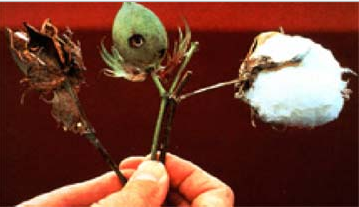What is Bt?
- Bacillus thuringiensis (Bt) is a spore forming bacterium that produces crystals protein (cry proteins), which are toxic to many species of insects.
Where is Bt found?
- Bt can be found almost everywhere in the world. Surveys have indicated that Bt is distributed in the soil sparsely but frequently worldwide.
- Bt has been found in all types of terrain, including beaches, desert, and tundra habitats.
How many kinds of Bt are there?
- There are thousands of different Bt strains, producing over 200 cry proteins that are active against an extensive range of insects and some other invertebrates.
Where is Bt used?
- Bt is largely used in agriculture, especially organic farming. Bt is also used in urban aerial spraying programs, and in transgenic crops.
What is Genetically Modified Organisms (GMO)?
- When a gene from one organism is purposely moved to improve or change another organism in a laboratory, the result is a genetically modified organism (GMO). It is also sometimes called “transgenic” for transfer of genes.
Selective breeding technique and Transgenic technique:
- There are different ways of moving genes to produce desirable traits. For both plants and animals, one of the more traditional ways is through selective breeding.
- For example, a plant with a desired trait is chosen and bred to produce more plants with the desirable trait.
- More recently with the advancement of technology is another technique. This technique is applied in the laboratory where genes that express the desired trait is physically moved or added to a new plant to enhance the trait in that plant. Plants produced with this technology are transgenic.
- Often, this process is performed on crops to produce insect or herbicide resistant plants, they are referred to as Genetically Modified Crops (GM crops).
Most GM crops grown today have been developed to resist certain insect pests. There are GM plants being developed today to produce specific vitamins, resist plant viruses and even produce products for medical uses.
What is Bt cotton?
Bt cotton is a genetically modified organism (GMO) cotton variety, which produces an insecticide to bollworm. It is produced by Monsanto.
Results of insect infestation on Bt (right) and non-Bt (left) cotton bolls.

Bt cotton was the first genetically modified (GM) crop technology to be commercialised in India.
Three Bt cotton hybrids, developed by Mahyco Monsanto Biotech (MMB) joint venture, were approved by Indian authorities in early 2002.
Bt cotton controversy
- No data on Bt Cotton’s effectiveness under practical farming conditions
- NGOs have questioned the technology’s effectiveness
- Analysis of several years of Indian field trial data demonstrated that Bt technology can significantly reduce pesticide applications and increase effective yields under experimental conditions. This is in line with research from other countries.
- However, independent studies under practical farming conditions are not available in India and therefore, it is difficult to interpret the statements made by different interest groups.
- MMB claims sizeable benefits for Bt adopters
- Anti-biotechnology activists have declared the technology a complete failure
This controversy has become one of the focal points in the global debate on GM crops.
- Monsanto vs Indian Farmers
- Seed is the basis of agriculture; the means of production and the basis of farmers’ livelihoods.
- In less than two decades, cotton seed has been snatched from the hands of Indian farmers by Monsanto, displacing local varieties, introducing GMO Bt cotton seeds and coercing extravagant royalties from farmers.
- Since Monsanto’s entry into India in 1998, the price of cotton seeds has increased by almost 80,000% (from ₹5 – ₹9/KG to ₹ 1600 for 450 gms). 300,000 Indian farmers have committed suicide, trapped in vicious cycles of debt and crop failures, 84% of these suicides are attributed directly to Monsanto’s Bt cotton.
- Monsanto, Indian farmers and the Govt of India
There are 3 issues related to the state of seed and the current conflicts related to Monsanto, Indian farmers and the Govt of India.
- First is the farmers rights to reliable and affordable seed and with it the duty of the government to protect farmers right to livelihood and right to life. It is the government’s duty under Art 21 of the constitution to protect the life of all its citizens.
- Second is the issue of IPRs, patents, royalty, technology fees in the context of false claims and a failing technology, and the duty of Government to act to revoke a patent according to Article 64 and Article 66 of the Indian Patent Act. There is a show cause notice served to Monsanto by the Central Government regarding the patent.
- The third is the issue of monopoly on seed. The Government has a duty to prevent monopolies being established. The issue of monopoly is before the Competition Commission of India which has stated that Monsanto has violated Competition laws and there is Prima Facie evidence of monopoly.
(In tomorrow’s DNA, we shall discuss the controversy surrounding Monsanto and patent protection.)
Connecting the dots:
- Write a brief note on genetically modified crops and how they differ from hybrid crops. What are the possible challenges and benefits of GM crops?
- What do you understand by the term “Bt”? Discuss the controversy surrounding Bt Cotton in India.
No comments:
Post a Comment